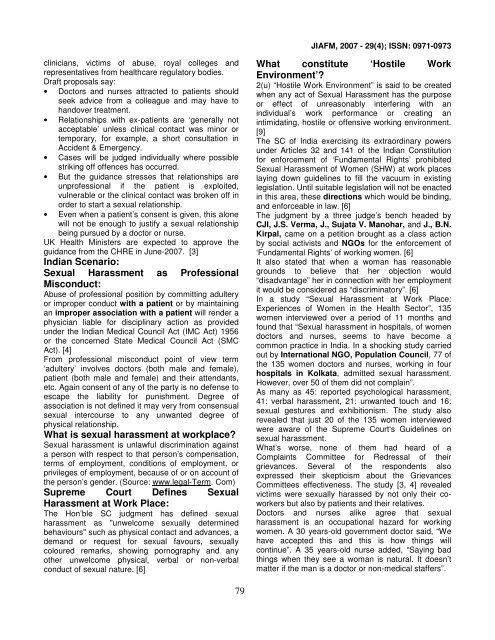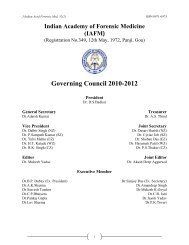Download - forensic medicine
Download - forensic medicine
Download - forensic medicine
Create successful ePaper yourself
Turn your PDF publications into a flip-book with our unique Google optimized e-Paper software.
JIAFM, 2007 - 29(4); ISSN: 0971-0973<br />
clinicians, victims of abuse, royal colleges and<br />
representatives from healthcare regulatory bodies.<br />
Draft proposals say:<br />
• Doctors and nurses attracted to patients should<br />
seek advice from a colleague and may have to<br />
handover treatment.<br />
• Relationships with ex-patients are ‘generally not<br />
acceptable’ unless clinical contact was minor or<br />
temporary, for example, a short consultation in<br />
Accident & Emergency.<br />
• Cases will be judged individually where possible<br />
striking off offences has occurred.<br />
• But the guidance stresses that relationships are<br />
unprofessional if the patient is exploited,<br />
vulnerable or the clinical contact was broken off in<br />
order to start a sexual relationship.<br />
• Even when a patient’s consent is given, this alone<br />
will not be enough to justify a sexual relationship<br />
being pursued by a doctor or nurse.<br />
UK Health Ministers are expected to approve the<br />
guidance from the CHRE in June-2007. [3]<br />
Indian Scenario:<br />
Sexual Harassment as Professional<br />
Misconduct:<br />
Abuse of professional position by committing adultery<br />
or improper conduct with a patient or by maintaining<br />
an improper association with a patient will render a<br />
physician liable for disciplinary action as provided<br />
under the Indian Medical Council Act (IMC Act) 1956<br />
or the concerned State Medical Council Act (SMC<br />
Act). [4]<br />
From professional misconduct point of view term<br />
‘adultery’ involves doctors (both male and female),<br />
patient (both male and female) and their attendants,<br />
etc. Again consent of any of the party is no defense to<br />
escape the liability for punishment. Degree of<br />
association is not defined it may very from consensual<br />
sexual intercourse to any unwanted degree of<br />
physical relationship.<br />
What is sexual harassment at workplace?<br />
Sexual harassment is unlawful discrimination against<br />
a person with respect to that person’s compensation,<br />
terms of employment, conditions of employment, or<br />
privileges of employment, because of or on account of<br />
the person’s gender. (Source: www.legal-Term. Com)<br />
Supreme Court Defines Sexual<br />
Harassment at Work Place:<br />
The Hon’ble SC judgment has defined sexual<br />
harassment as "unwelcome sexually determined<br />
behaviours" such as physical contact and advances, a<br />
demand or request for sexual favours, sexually<br />
coloured remarks, showing pornography and any<br />
other unwelcome physical, verbal or non-verbal<br />
conduct of sexual nature. [6]<br />
What constitute ‘Hostile Work<br />
Environment’?<br />
2(u) “Hostile Work Environment” is said to be created<br />
when any act of Sexual Harassment has the purpose<br />
or effect of unreasonably interfering with an<br />
individual’s work performance or creating an<br />
intimidating, hostile or offensive working environment.<br />
[9]<br />
The SC of India exercising its extraordinary powers<br />
under Articles 32 and 141 of the Indian Constitution<br />
for enforcement of ‘Fundamental Rights’ prohibited<br />
Sexual Harassment of Women (SHW) at work places<br />
laying down guidelines to fill the vacuum in existing<br />
legislation. Until suitable legislation will not be enacted<br />
in this area, these directions which would be binding,<br />
and enforceable in law. [6]<br />
The judgment by a three judge’s bench headed by<br />
CJI, J.S. Verma, J., Sujata V. Manohar, and J., B.N.<br />
Kirpal, came on a petition brought as a class action<br />
by social activists and NGOs for the enforcement of<br />
‘Fundamental Rights’ of working women. [6]<br />
It also stated that when a woman has reasonable<br />
grounds to believe that her objection would<br />
“disadvantage” her in connection with her employment<br />
it would be considered as “discriminatory”. [6]<br />
In a study “Sexual Harassment at Work Place:<br />
Experiences of Women in the Health Sector”, 135<br />
women interviewed over a period of 11 months and<br />
found that “Sexual harassment in hospitals, of women<br />
doctors and nurses, seems to have become a<br />
common practice in India. In a shocking study carried<br />
out by International NGO, Population Council, 77 of<br />
the 135 women doctors and nurses, working in four<br />
hospitals in Kolkata, admitted sexual harassment.<br />
However, over 50 of them did not complain”.<br />
As many as 45: reported psychological harassment,<br />
41: verbal harassment, 21: unwanted touch and 16:<br />
sexual gestures and exhibitionism. The study also<br />
revealed that just 20 of the 135 women interviewed<br />
were aware of the Supreme Court‘s Guidelines on<br />
sexual harassment.<br />
What’s worse, none of them had heard of a<br />
Complaints Committee for Redressal of their<br />
grievances. Several of the respondents also<br />
expressed their skepticism about the Grievances<br />
Committees effectiveness. The study [3, 4] revealed<br />
victims were sexually harassed by not only their coworkers<br />
but also by patients and their relatives.<br />
Doctors and nurses alike agree that sexual<br />
harassment is an occupational hazard for working<br />
women. A 30 years-old government doctor said, “We<br />
have accepted this and this is how things will<br />
continue”. A 35 years-old nurse added, “Saying bad<br />
things when they see a woman is natural. It doesn’t<br />
matter if the man is a doctor or non-medical staffers”.<br />
79




![syllabus in forensic medicine for m.b.b.s. students in india [pdf]](https://img.yumpu.com/48405011/1/190x245/syllabus-in-forensic-medicine-for-mbbs-students-in-india-pdf.jpg?quality=85)



![SPOTTING IN FORENSIC MEDICINE [pdf]](https://img.yumpu.com/45856557/1/190x245/spotting-in-forensic-medicine-pdf.jpg?quality=85)

![JAFM-33-2, April-June, 2011 [PDF] - forensic medicine](https://img.yumpu.com/43461356/1/190x245/jafm-33-2-april-june-2011-pdf-forensic-medicine.jpg?quality=85)



![JIAFM-33-4, October-December, 2011 [PDF] - forensic medicine](https://img.yumpu.com/31013278/1/190x245/jiafm-33-4-october-december-2011-pdf-forensic-medicine.jpg?quality=85)

